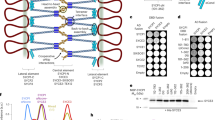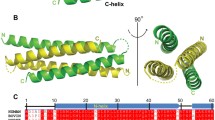Abstract
Synaptonemal complexes (SCs) are evolutionarily conserved meiosis-specific nuclear structures critically involved in synapsis, recombination, and segregation of homologous chromosomes. SCs are proteinaceous structures composed of (a) two lateral elements (LEs), to which the chromatin of the homologs is attached, (b) numerous transverse filaments (TFs) that link the LEs, and (c) a central element (CE). Major protein components of mammalian SCs are the TF protein SYCP1 and the LE proteins SYCP2 and SCYP3. How SCs become assembled is presently poorly understood, in particular, it is not known how TFs assemble at the plane of LEs to interconnect the homologous chromosomes. Therefore, we have investigated possible interactions between SYCP1 and other SC proteins. In immunoprecipitation experiments we could find that SYCP1 and SYCP2 interact in extracts of meiotic cells. Using the yeast two-hybrid system, we were able to demonstrate that the C-terminus of SYCP1 directly interacts with SYCP2. These results were confirmed by different interaction traps. Furthermore, we could narrow down the interacting domain of the SYCP2 molecule to its C-terminal region. We propose that SYCP2 acts as a linker between SYCP1 and SYCP3 and therefore would be the missing connecting link between LEs and TFs essential for proper chromosome synapsis.





Similar content being viewed by others
References
Alsheimer M, Benavente R (1996) Change of karyoskeleton during mammalian spermatogenesis: expression pattern of meiotic lamin C2 and its regulation. Exp Cell Res 228:181–188
Alsheimer M, von Glasenapp E, Schnölzer M, Heid H, Benavente R (2000) Meiotic lamin C2: the unique amino-terminal hexapeptide GNAEGR is essential for nuclear envelope association. Proc Natl Acad Sci U S A 97:13120–13125
Baier A, Alsheimer M, Volff JN, Benavente R (2007a) Synaptonemal complex protein SYCP3 of the rat: evolutionarily conserved domains and the assembly of higher order structures. Sex Dev 1:161–168
Baier A, Alsheimer M, Benavente R (2007b) Synaptonemal complex protein SYCP3: conserved polymerization properties among vertebrates. Biochim Biophys Acta 1174:595–602
Bolcun-Filas E, Costa Y, Speed R, Taggart M, Benavente R, de Rooij DG, Cooke HJ (2007) SYCP2 is required for synaptonemal complex assembly, DSB repair and homologous recombination. J Cell Biol 176:741–747
Costa Y, Cooke HJ (2007) Dissecting the mammalian synaptonemal complex using targeted mutations. Chromosome Res 15:579–589
Costa Y, Speed R, Öllinger R, Alsheimer M, Semple CA, Gautier P, Maratou K, Novak I, Höög C, Benavente R, Cooke HJ (2005) Two novel proteins recruited by synaptonemal complex protein 1 (SYCP1) are at the centre of meiosis. J Cell Sci 118:2755–2762
de Vries FA, de Boer E, van den Bosch M, Baarends WM, Ooms M, Yuan L, Liu JG, van Zeeland AA, Heyting C, Pastink A (2005) Mouse Sycp1 functions in synaptonemal complex assembly, meiotic recombination, and XY body formation. Genes Dev 19:1376–1389
Dobson MJ, Pearlmen RE, Karaiskakis A, Spyropoulos B, Moens PB (1994) Synaptonemal complex proteins: occurrence, epitope mapping and chromosome disjunction. J Cell Sci 107:2749–2760
Gietz RD, Schiestl RH, Willems AR, Woods RA (1995) Studies on the transformation of intact yeast cells by the LiAc/SS-DNA/PEG procedure. Yeast 11:355–60
Hamer G, Gell K, Kouznetsova A, Novak I, Benavente R, Höög C (2006) Characterization of a novel meiosis-specific protein within the central element of the synaptonemal complex. J Cell Sci 119:4025–4032
Hamer G, Wang H, Bolcun-Filas E, Cooke HJ, Benavente R, Höög C (2008) Progression of meiotic recombination requires structural maturation of the synaptonemal complex. J Cell Sci 121:2445–2451
Hernández-Hernández A, Rincón-Arano H, Recillas-Targa F, Ortiz R, Valdes-Quesada C, Echeverría OM, Benavente R, Vázquez-Nin GH (2008) Differential distribution and association of repeat DNA sequences in the lateral element of the synaptonemal complex in rat spermatocytes. Chromosoma 117:77–87
Heyting C, Dietrich AJ (1991) Meiotic chromosome preparation and labeling. Methods Cell Biol 35:177–202
Laemmli UK (1970) Cleavage of structural proteins during the assembly of the head of bacteriophage T4. Nature 227:680–685
Lammers JH, Offenberg HH, van Aalderen M, Vink AC, Dietrich AJ, Heyting C (1994) The gene encoding a major component of the lateral elements of synaptonemal complexes of the rat is related to X-linked lymphocyte-regulated genes. Mol Cell Biol 14:1137–1146
Liebe B, Alsheimer M, Höög C, Benavente R, Scherthan H (2004) Telomere attachment, meiotic chromosome condensation, pairing and bouquet stage duration are modified in spermatocytes lacking axial elements. Mol Biol Cell 15:827–837
Liu JG, Yuan L, Brundell E, Björkroth B, Daneholt B, Höög C (1996) Localization of the N-terminus of SCP1 to the central element of the synaptonemal complex and evidence for direct interactions between the N-termini of SCP1 molecules organized head-to-head. Exp Cell Res 226:11–19
Meuwissen RL, Offenberg HH, Dietrich AJ, Riesewijk A, van Iersel M, Heyting C (1992) A coiled-coil related protein specific for synapsed regions of meiotic prophase chromosomes. EMBO J 11:5091–5100
Novak I, Wang H, Revenkova E, Jessberger R, Scherthan H, Höög C (2008) Cohesin SMC1β determines meiotic chromatin axis loop organization. J Cell Biol 180:83–90
Offenberg HH, Schalk JA, Meuwissen RL, van Aalderen M, Kester HA, Dietrich AJ, Heyting C (1998) SCP2: a major protein component of the axial elements of synaptonemal complexes of the rat. Nucleic Acids Res 26:2572–2579
Öllinger R, Alsheimer M, Benavente R (2005) Mammalian protein SCP1 forms synaptonemal complex-like structures in the absence of meiotic chromosomes. Mol Biol Cell 16:212–217
Page SL, Hawley RS (2004) The genetics and molecular biology of the synaptonemal complex. Annu Rev Cell Dev Biol 20:525–558
Pearlman RE, Tsao N, Moens PB (1992) Synaptonemal complexes from DNase-treated rat pachytene chromosomes contain (GT)n and LINE/SINE sequences. Genetics 130:865–872
Pelttari J, Hoja MR, Yuan L, Liu JG, Brundell E, Moens P, Santucci-Darmanin S, Jessberger R, Barbero JL, Heyting C, Höög C (2001) A meiotic chromosomal core consisting of cohesin complex proteins recruits DNA recombination proteins and promotes synapsis in the absence of an axial element in mammalian meiotic cells. Mol Cell Biol 21:5667–5677
Rattner JB, Goldsmith M, Hamkalo B (1980) Chromatin organization during meiotic prophase of Bombyx mori. Chromosoma 79:215–224
Schmekel K, Meuwissen RL, Dietrich AJ, Vink AC, van Marle J, van Veen H, Heyting C (1996) Organization of SCP1 protein molecules within synaptonemal complexes of the rat. Exp Cell Res 226:20–30
Tarsounas M, Pearlmen RE, Gasser PJ, Park MS, Moens PB (1997) Protein–protein interactions in the synaptonemal complex. Mol Biol Cell 8:1405–1414
Yang F, de la Fuente R, Leu NA, Baumann C, McLaughlin KJ, Wang PJ (2006) Mouse SYCP2 is required for synaptonemal complex assembly and chromosomal synapsis during male meiosis. J Cell Biol 173:497–507
Yuan L, Pelttari J, Brundell E, Björkroth B, Zhao J, Liu JG, Brismar H, Daneholt B, Höög C (1998) The synaptonemal complex protein SCP3 can form multistranded, cross-striated fibers in vivo. J Cell Biol 142:331–339
Yuan L, Liu JG, Zhao J, Brundell E, Daneholt B, Höög C (2000) The murine SCP3 gene is required for synaptonemal complex assembly, chromosome synapsis, and male fertility. Mol Cell 5:73–82
Zickler D, Kleckner N (1998) The leptotene–zygotene transition of meiosis. Annu Rev Genet 32:619–697
Acknowledgements
This work was supported by grants of the Deutsche Forschungsgemeinschaft (Be 1168/6-3) and the Graduate School ‘Tumor Instability’ to R.B.
Author information
Authors and Affiliations
Corresponding authors
Additional information
Communicated by: E.A. Nigg
Rights and permissions
About this article
Cite this article
Winkel, K., Alsheimer, M., Öllinger, R. et al. Protein SYCP2 provides a link between transverse filaments and lateral elements of mammalian synaptonemal complexes. Chromosoma 118, 259–267 (2009). https://doi.org/10.1007/s00412-008-0194-0
Received:
Revised:
Accepted:
Published:
Issue Date:
DOI: https://doi.org/10.1007/s00412-008-0194-0




